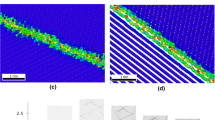Abstract
Molecular dynamic simulation was used to calculate the critical stresses necessary for dislocations to nucleate and move in the dynamic friction mode and determine the coefficients of dislocation phonon friction in metals with point defects and Guinier-Preston (GP) zones (in the Al-Cu alloy) taken into account. The temperature dependencies of the critical stresses required to overcome the GP zones in Al at different speeds of dislocation motion were analyzed to distinguish the thermofluctuation and dynamic (weakly depending on T) contributions to the yield strength at high-rate deformations. It was noted that the dislocation nucleation stresses strongly decrease with increasing temperature in the defect-free case and the stresses of dislocation heterogeneous nucleation on GP clusters remain nearly unchanged.
Similar content being viewed by others
References
G. I. Kanel, V. E. Fortov, and S. V. Razorenov, “Shock Waves in Condensed-State Physics,” Uspekhi Fiz. Nauk 177(8), 809–830 (2007) [Phys. Uspekhi (Engl. Transl.) 50 (8), 771–791 (2007)].
V. I. Al’shits and V. L. Indenbom, “Dynamical Drag on Dislocations,” Uspekhi Fiz. Nauk 115(1), 3–38 (1975). [Sov. Phys. Usp. (Engl. Transl) 18 (1), 1–20 (1975)].
G. I. Kanel, S. V. Razorenov, A. V. Utkin, and V. E. Fortov, Shock-Wave Phenomena in Condensed Media (Yanus-K, Moscow, 1996) [in Russian].
G. I. Kanel, S. V. Razorenov, K. Baumung, and J. Singer, “Dynamic Yield and Tensile Strength of Aluminum Single Crystals at Temperatures up to the Melting Point,” J. Appl. Phys. 90(1), 136–143 (2001).
E. V. Zaretsky and G. I. Kanel, “Response of Copper to Shock-Wave Loading at Temperatures up to the Melting Point,” J. Appl. Phys. 114(8), 083511 (2013).
S. I. Ashitkov, M. B. Agranat, G. I. Kanel, et al., “Behavior of Aluminum near an Ultimate Theoretical Strength in Experiments with Femtosecond Laser Pulses,” Pis’ma Zh. Eksp. Teor. Fiz. 92(8), 568–573 (2010). [JETP Lett. (Engl. Transl.) 92 (8), 516–520 (2010)].
R. F. Smith, J. H. Eggert, R. E. Rudd, et al., “High Strain-Rate Plastic Flow in Al and Fe,” J. Appl. Phys. 110(12), 123515 (2011).
G. E. Norman and V. V. Stegailov, “Stochastic Theory of the Classical Molecular Dynamics Method,” Mat. Modelirovanie 24(6), 3–44 (2012) [Math. Models Comput. Simul. (Engl. Transl.) 5 (4), 305–333 (2013)].
M. S. Daw, S. M. Foiles, and M. I. Baskes, “EAM: A Review of Theory and Application,” Mater. Sci. Rep. 9, 251 (1992).
X. -Y. Liu, X. Wei, S. M. Foiles, and J. B. Adams, “Atomistic Studies of Segregation and Diffusion in Al-Cu Grain Boundaries,” Appl. Phys. Lett. 72(13), 1578 (1998).
F. Apostol and Y. Mishin, “Interatomic Potential for the Al-Cu System,” Phys. Rev. B 83, 054116 (2011).
S.V. Starikov, Z. Insepov, J. Rest, et al., “Radiation-Induced Damage and Evolution of Defects in Mo,” Phys. Rev. B 84(10), 104109 (2011).
M. I. Mendelev, S. Han, D. J. Srolovitz, et al., “Development of New Interatomic Potentials Appropriate for Crystalline and Liquid Iron,” Phil. Mag. 83, 3977 (2003).
A. Yu. Kuksin and A. V. Yanilkin, “Atomistic Simulation of the Motion of Dislocations in Metals under Phonon Drag Conditions,” Fiz. Tverd. Tela 55(5), 931–939 (2013) [Phys. Solid State (Engl. Transl.) 55 (5), 1010–1119 (2013)].
S. J. Plimpton, “Fat Parallel Algorithms for Short-Range Molecular Dynamics,” J. Comput. Phys. 117, 1 (1995).
F.W. Gayle and M. Goodway, “Precipitation Hardening in the First Aerospace Aluminum Alloy: The Wright Flyer Crankcase,” Science 266, 1015 (1994).
A. Yu. Kuksin, V. V. Stegailov, and A. V. Yanilkin, “Molecular-Dynamics Simulation of Edge-Dislocation Dynamics in Aluminum,” Dokl. Ross. Akad. Nauk 420, 467–471 (2008) [Dokl. Phys. (Engl. Transl.) 53 (6), 287–291 (2008)].
A. V. Yanilkin, V. S. Krasnikov, A. Yu. Kuksin, and A. E. Mayer, “Dynamics and Kinetics of Dislocations in Al and Al-Cu Alloy under Dynamic Loading,” Int. J. Plasticity 55, 94–107 (2014).
M. Itakura, H. Kaburaki, and M. Yamaguchi, “First-Principles Study on the Mobility of Screw Dislocations in BCC Iron,” Acta Mater. 60, 3698–3710 (2012).
M. R. Gilbert, P. Schuck, B. Sadigh, and J. Marian, “Free Energy Generalization of the Peierls Potential in Iron,” Phys. Rev. Lett. 111, 095502 (2013).
T. D. Swinburne, S. L. Dudarev, S. P. Fitzgerald, et al., “Theory and Simulation of the Diffusion of Kinks on Dislocations in BCC Metals,” Phys. Rev. B 87, 064108 (2013).
T. Suzuki, S. Takeuchi, and H. Yoshinaga, Dislocation Dynamics and Plasticity (Springer-Verlag, 1985; Mir, Moscow, 1989).
D. L. Olmsted, L. G. Hector, Jr., W. A. Gurtin, and R. J. Clifton, “Atomistic Simulatios of Dislocation Mobilityin Al, Ni, and Al/Mg Alloys,” Model. Simul. Mater. Sci. Engng 13, 371–378 (2005).
K. Tapasa, D. J. Bacon, and Yu. N. Osetsky, “Computer Simulation of Dislocation-Solute Interaction in Dilute Fe-Cu Alloys,” Model. Simul. Mater. Sci. Engng 14, 1153 (2006).
G. V. Garkushin, S. V. Razorenov, and G. I. Kanel, “Submicrosecond Strength of the D16T Aluminum Alloy at Room and Elevated Temperatures,” Fiz. Tverd. Tela 50(5), 805–811 (2008) [Phys. Solid State (Engl. Transl.) 50 (5), 839–843 (2008)].
R. K. Rajgarhia, D. E. Spearot, and A. Saxena, “Heterogeneous Dislocation Nucleation in Single Crystal Copper-Antimony Solid-Solution Alloys,” Model. Simul. Mater. Sci. Engng 17(5), 055001 (2005).
Author information
Authors and Affiliations
Corresponding author
Additional information
Original Russian Text © A.Yu. Kuksin, A.V. Yanilkin, 2015, published in Izvestiya Akademii Nauk. Mekhanika Tverdogo Tela, 2015, No. 1, pp. 54–62.
About this article
Cite this article
Kuksin, A.Y., Yanilkin, A.V. Dislocation nucleation and motion in metals and alloys at high-rate deformation: Molecular dynamic simulation. Mech. Solids 50, 44–51 (2015). https://doi.org/10.3103/S0025654415010057
Received:
Published:
Issue Date:
DOI: https://doi.org/10.3103/S0025654415010057




